

Turkey (Turkish: Türkiye), known officially as the Republic of Turkey (Türkiye Cumhuriyeti (help info)), is a Eurasian country that stretches across the Anatolian peninsula in western Asia and Thrace (Rumelia) in the Balkan region of southeastern Europe. Turkey borders eight countries: Bulgaria to the northwest; Greece to the west, Georgia to the northeast; Armenia, Azerbaijan (the exclave of Nakhichevan), and Iran to the east; and Iraq and Syria to the southeast. The Mediterranean Sea and Cyprus are to the south; the Aegean Sea and Archipelago are to the west; and the Black Sea is to the north. Separating Anatolia and Thrace are the Sea of Marmara and the Turkish Straits (the Bosporus and the Dardanelles), which are commonly reckoned to delineate the border between Asia and Europe, thereby making Turkey transcontinental.
Due to its strategic location astride two continents, Turkey's culture has a unique blend of Eastern and Western tradition. A powerful regional presence in the Eurasian landmass with strong historic, cultural and economic influence in the area between the European Union in the west and Central Asia in the east, Russia in the north and the Middle East in the south, Turkey has come to acquire increasing strategic significance.
Turkey, classified as a developed country by the CIA, is a democratic, secular, unitary, constitutional republic whose political system was established in 1923 under the leadership of Mustafa Kemal Atatürk, following the fall of the Ottoman Empire in the aftermath of World War I. Since then, Turkey has become increasingly integrated with the West while continuing to foster relations with the Eastern world.
Etymology
The name of Turkey, Türkiye in the Turkish language, can be divided into two words: Türk, which means "strong" in Old Turkic and usually signifying the inhabitants of Turkey or a member of the Turkish or Turkic peoples, a later form of "tu-kin", name given by the Chinese to the people living south of the Altay Mountains of Central Asia as early as 177 BCE; and the abstract suffix -iye (derived from Arabic), which means "owner" or "related to". The first recorded use of the term "Türk" or "Türük" as an autonym is contained in the Orkhon inscriptions of the Göktürks (Sky Turks) of Central Asia (c. 8th century CE). The English word "Turkey" is derived from the Medieval Latin "Turchia" (c. 1369).
Pre-Turkic history of Anatolia
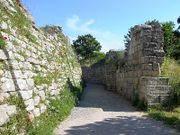 Portion of the legendary walls of Troy (VII), identified as the site of the Trojan War (ca. 1200 BCE)The Anatolian peninsula (also called Asia Minor), comprising most of modern Turkey, is one of the oldest continually inhabited regions in the world due to its location at the intersection of Asia and Europe. The earliest Neolithic settlements such as Çatalhöyük (Pottery Neolithic), Çayönü (Pre-Pottery Neolithic A to Pottery Neolithic), Nevali Cori (Pre-Pottery Neolithic B), Hacilar (Pottery Neolithic), Göbekli Tepe (Pre-Pottery Neolithic A) and Mersin are considered to be among the earliest human settlements in the world. The settlement of Troy starts in the Neolithic and continues into the Iron Age. Through recorded history, Anatolians have spoken Indo-European, Semitic and Kartvelian languages, as well as many languages of uncertain affiliation. In fact, given the antiquity of the Indo-European Hittite and Luwian languages, some scholars have proposed Anatolia as the hypothetical center from which the Indo-European languages have radiated.
Portion of the legendary walls of Troy (VII), identified as the site of the Trojan War (ca. 1200 BCE)The Anatolian peninsula (also called Asia Minor), comprising most of modern Turkey, is one of the oldest continually inhabited regions in the world due to its location at the intersection of Asia and Europe. The earliest Neolithic settlements such as Çatalhöyük (Pottery Neolithic), Çayönü (Pre-Pottery Neolithic A to Pottery Neolithic), Nevali Cori (Pre-Pottery Neolithic B), Hacilar (Pottery Neolithic), Göbekli Tepe (Pre-Pottery Neolithic A) and Mersin are considered to be among the earliest human settlements in the world. The settlement of Troy starts in the Neolithic and continues into the Iron Age. Through recorded history, Anatolians have spoken Indo-European, Semitic and Kartvelian languages, as well as many languages of uncertain affiliation. In fact, given the antiquity of the Indo-European Hittite and Luwian languages, some scholars have proposed Anatolia as the hypothetical center from which the Indo-European languages have radiated.
The Celsus Library in Ephesus, dating from 135 CEThe first major empire in the area was that of the Hittites, from the 18th through the 13th century BCE. Subsequently, the Phrygians, an Indo-European people, achieved ascendancy until their kingdom was destroyed by the Cimmerians in the 7th century BCE. The most powerful of Phrygia's successor states were Lydia, Caria and Lycia. The Lydians and Lycians spoke languages that were fundamentally Indo-European, but both languages had acquired non-Indo-European elements prior to the Hittite and Hellenic periods.
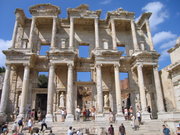 The west coast of Anatolia was meanwhile settled by the Ionians, one of the ancient Greek peoples. The entire area was conquered by the Persian Achaemenid Empire during the 6th and 5th centuries and later fell to Alexander the Great in 334 BCE. Anatolia was subsequently divided into a number of small Hellenistic kingdoms (including Bithynia, Cappadocia, Pergamum, and Pontus), all of which had succumbed to Rome by the mid-1st century BCE. In 324 CE, the Roman emperor Constantine I chose Byzantium to be the new capital of the Roman Empire, renaming it New Rome (later Constantinople and Istanbul). After the fall of the Western Roman Empire, it became the capital of the Byzantine Empire (Eastern Roman Empire).
The west coast of Anatolia was meanwhile settled by the Ionians, one of the ancient Greek peoples. The entire area was conquered by the Persian Achaemenid Empire during the 6th and 5th centuries and later fell to Alexander the Great in 334 BCE. Anatolia was subsequently divided into a number of small Hellenistic kingdoms (including Bithynia, Cappadocia, Pergamum, and Pontus), all of which had succumbed to Rome by the mid-1st century BCE. In 324 CE, the Roman emperor Constantine I chose Byzantium to be the new capital of the Roman Empire, renaming it New Rome (later Constantinople and Istanbul). After the fall of the Western Roman Empire, it became the capital of the Byzantine Empire (Eastern Roman Empire).
Turks and the Ottoman Empire
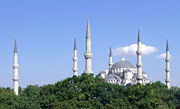 The Ottoman Empire at the height of its power (ca. 1680) The Sultan Ahmed Mosque (Blue Mosque) is one of the most famous architectural legacies of the Ottoman Empire.The House of Seljuk was a branch of the Kınık Oğuz Turks who in the 9th century resided on the periphery of the Muslim world, north of the Caspian and Aral Seas in the Yabghu Khaganate of the Oğuz confederacy. In the 10th century, the Seljuks started migrating from their ancestral homelands towards the eastern regions of Anatolia, which eventually became the new homeland of Oğuz Turkic tribes following the Battle of Manzikert (Malazgirt) in 1071. The victory of the Seljuks gave rise to the Anatolian Seljuk Sultanate; which developed as a separate branch of the larger Seljuk Empire that covered parts of Central Asia, Iran, Anatolia and the Middle East.
The Ottoman Empire at the height of its power (ca. 1680) The Sultan Ahmed Mosque (Blue Mosque) is one of the most famous architectural legacies of the Ottoman Empire.The House of Seljuk was a branch of the Kınık Oğuz Turks who in the 9th century resided on the periphery of the Muslim world, north of the Caspian and Aral Seas in the Yabghu Khaganate of the Oğuz confederacy. In the 10th century, the Seljuks started migrating from their ancestral homelands towards the eastern regions of Anatolia, which eventually became the new homeland of Oğuz Turkic tribes following the Battle of Manzikert (Malazgirt) in 1071. The victory of the Seljuks gave rise to the Anatolian Seljuk Sultanate; which developed as a separate branch of the larger Seljuk Empire that covered parts of Central Asia, Iran, Anatolia and the Middle East.
In 1243, the Seljuk armies were defeated by the Mongols and the power of the empire slowly disintegrated. In its wake, one of the Turkish principalities governed by Osman I was to evolve into the Ottoman Empire, thus filling the void left by the collapsed Seljuks and Byzantines.
The Ottoman Empire interacted with both Eastern and Western cultures throughout its 623-year history. In the 16th and 17th centuries, it was among the world's most powerful political entities, often locking horns with the Holy Roman Empire in its steady advance towards Central Europe through the Balkans and the southern part of the Polish-Lithuanian Commonwealth on land; and with the combined forces (Holy Leagues) of Habsburg Spain, the Republic of Venice and the Knights of St. John at sea for the control of the Mediterranean basin; while frequently confronting Portuguese fleets at the Indian Ocean for defending the Empire's monopoly over the ancient maritime trade routes between East Asia and Western Europe, which had become increasingly compromised since the discovery of the Cape of Good Hope in 1488.
Following years of decline, the Ottoman Empire entered World War I through the Ottoman-German Alliance in 1914, and was ultimately defeated. After the war, the victorious Allied Powers sought the dismemberment of the Ottoman state through the Treaty of Sèvres.
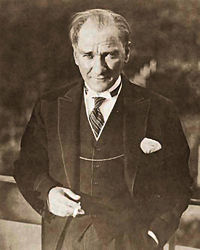 Republic era
Republic era
Mustafa Kemal Atatürk, founder and first President of the Republic of TurkeyThe occupation of İstanbul and İzmir by the Allies in the aftermath of World War
I prompted the establishment of the Turkish national movement. Under the leadership of Mustafa Kemal Pasha, a military commander who had distinguished himself during the Battle of Gallipoli, the Turkish War of Independence was waged with the aim of revoking the terms of the Treaty of Sèvres. By September 18, 1922, the occupying armies were repelled and the country saw the birth of the new Turkish state. On November 1, the newly founded parliament formally abolished the Sultanate, thus ending 623 years of Ottoman rule. The Treaty of Lausanne of 1923 led to the international recognition of the sovereignty of the newly formed "Republic of Turkey" as the successor state of the Ottoman Empire, and the republic was officially proclaimed on October 29, 1923, in the new capital of Ankara Mustafa Kemal became the republic's first president and subsequently introduced many radical reforms with the aim of founding a new secular republic from the remnants of its Ottoman past. According to the Law on Family Names, the Turkish parliament presented Mustafa Kemal with the honorific name "Atatürk" (Father of the Turks) in 1934.
Turkey entered World War II on the side of the Allies on February 23, 1945 as a ceremonial gesture and became a charter member of the United Nations in 1945. Difficulties faced by Greece after the war in quelling a communist rebellion, along with demands by the Soviet Union for military bases in the Turkish Straits, prompted the United States to declare the Truman Doctrine in 1947. The doctrine enunciated American intentions to guarantee the security of Turkey and Greece, and resulted in large-scale US military and economic support.
After participating with United Nations forces in the Korean conflict, Turkey joined the North Atlantic Treaty Organization (NATO) in 1952, becoming a bulwark against Soviet expansion into the Mediterranean. Following a decade of intercommunal violence on the island of Cyprus and the subsequent Athens inspired coup, Turkey intervened militarily in 1974. Nine years later Turkish Republic of Northern Cyprus (TRNC) was established. TRNC is recognised only by Turkey.
Following the end of the single-party period in 1945, the multi-party period witnessed tensions over the following decades, and the period between the 1960s and the 1980s was particularly marked by periods of political instability that resulted in a number of military coups d'états in 1960, 1971, 1980 and a post-modern coup d'état in 1997. The liberalization of the Turkish economy that started in the 1980s changed the landscape of the country, with successive periods of high growth and crises punctuating the following decades.
Government and politics
Politics of Turkey, Constitution of Turkey, and Elections in Turkey Turkey is a parliamentary representative democracy. Since its foundation as a republic in 1923, Turkey has developed a strong tradition of secularism. Turkey's constitution governs the legal framework of the country. It sets out the main principles of government and establishes Turkey as a unitary centralized state.
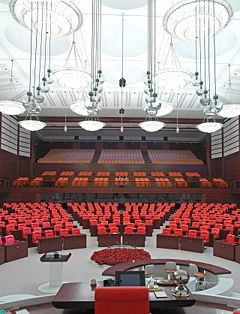 The Grand Chamber of the Grand National Assembly of Turkey in AnkaraThe head of state is the President of the Republic and has a largely ceremonial role. The president is elected for a seven-year term by the parliament but is not required to be one of its members. The last President, Ahmet Necdet Sezer, was elected on May 16, 2000, after having served as the President of the Constitutional Court. He was succeeded on August 28, 2007 by Abdullah Gül. Executive power is exercised by the Prime Minister and the Council of Ministers which make up the government, while the legislative power is vested in the unicameral parliament, the Grand National Assembly of Turkey. The judiciary is independent of the executive and the legislature, and the Constitutional Court is charged with ruling on the conformity of laws and decrees with the constitution. The Council of State is the tribunal of last resort for administrative cases, and the High Court of Appeals for all others.
The Grand Chamber of the Grand National Assembly of Turkey in AnkaraThe head of state is the President of the Republic and has a largely ceremonial role. The president is elected for a seven-year term by the parliament but is not required to be one of its members. The last President, Ahmet Necdet Sezer, was elected on May 16, 2000, after having served as the President of the Constitutional Court. He was succeeded on August 28, 2007 by Abdullah Gül. Executive power is exercised by the Prime Minister and the Council of Ministers which make up the government, while the legislative power is vested in the unicameral parliament, the Grand National Assembly of Turkey. The judiciary is independent of the executive and the legislature, and the Constitutional Court is charged with ruling on the conformity of laws and decrees with the constitution. The Council of State is the tribunal of last resort for administrative cases, and the High Court of Appeals for all others.
The Prime Minister is elected by the parliament through a vote of confidence in his government and is most often the head of the party that has the most seats in parliament. The current Prime Minister is the former mayor of İstanbul, Recep Tayyip Erdoğan, whose conservative AKP won an absolute majority of parliamentary seats in the 2002 general elections, organized in the aftermath of the economic crisis of 2001, with 34% of the suffrage. In the 2007 general elections, AKP received 46.6% of the votes and could defend its majority in parliament. Neither the Prime Minister nor the Ministers have to be members of the parliament, but in most cases they are (one notable exception was Kemal Derviş, the Minister of State in Charge of Economy following the financial crisis of 2001; he is currently the president of the United Nations Development Programme).
Universal suffrage for both sexes has been applied throughout Turkey since 1933, and every Turkish citizen who has turned 18 years of age has the right to vote. As of 2004, there were 50 registered political parties in the country, whose ideologies range from the far left to the far right. The Constitutional Court can strip the public financing of political parties that it deems anti-secular or separatist, or ban their existence altogether.
There are 550 members of parliament who are elected for a four-year term by a party-list proportional representation system from 85 electoral districts which represent the 81 administrative provinces of Turkey (İstanbul is divided into three electoral districts whereas Ankara and İzmir are divided into two each because of their large populations). To avoid a hung parliament and its excessive political fragmentation, only parties that win at least 10% of the votes cast in a national parliamentary election gain the right to representation in the parliament. As a result of this threshold, the 2007 elections saw three parties formally entering parliament (compared to two in 2002). However due to a system of alliances and independent candidatures, seven parties are currently represented in parliament. Independent candidates may run; however, they must also win at least 10% of the vote in their circonscription to be elected.
Foreign relations
Roosevelt, İnönü and Churchill at the Second Cairo Conference in December 1943Turkey is a founding member of the United Nations (1945), the OECD (1961), the OSCE (1973) and the G20 industrial nations (1999).
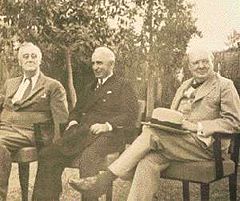 In line with its traditional Western orientation, relations with Europe have always been a central part of Turkish foreign policy. Turkey became a member of the Council of Europe in 1949, applied for associate membership of the EEC (predecessor of the EU) in 1959 and became an associate member in 1963. After decades of political negotiations, Turkey applied for full membership of the EEC in 1987, became an associate member of the Western European Union in 1992, reached a Customs Union agreement with the EU in 1995 and has officially begun formal accession negotiations with the EU on October 3, 2005. It is believed that the accession process will take at least 15 years due to Turkey's size and the depth of disagreements over certain issues. These include disputes with EU member Republic of Cyprus over Turkey's 1974 military intervention to prevent the island's annexation to Greece. Since then, Turkey does not recognize the essentially Greek Cypriot Republic of Cyprus as the sole authority on the island, but instead supports the Turkish Cypriot community in the form of the de facto Turkish Republic of Northern Cyprus.
In line with its traditional Western orientation, relations with Europe have always been a central part of Turkish foreign policy. Turkey became a member of the Council of Europe in 1949, applied for associate membership of the EEC (predecessor of the EU) in 1959 and became an associate member in 1963. After decades of political negotiations, Turkey applied for full membership of the EEC in 1987, became an associate member of the Western European Union in 1992, reached a Customs Union agreement with the EU in 1995 and has officially begun formal accession negotiations with the EU on October 3, 2005. It is believed that the accession process will take at least 15 years due to Turkey's size and the depth of disagreements over certain issues. These include disputes with EU member Republic of Cyprus over Turkey's 1974 military intervention to prevent the island's annexation to Greece. Since then, Turkey does not recognize the essentially Greek Cypriot Republic of Cyprus as the sole authority on the island, but instead supports the Turkish Cypriot community in the form of the de facto Turkish Republic of Northern Cyprus.
The other defining aspect of Turkey's foreign relations has been its ties with the United States. Based on the common threat posed by the Soviet Union, Turkey joined the NATO in 1952 ensuring close bilateral relations with Washington throughout the Cold War. In the post-Cold War environment, Turkey's geostrategic importance shifted towards its proximity to the volatile Middle East. As well as hosting an important American base near the Syrian/Iraq border for US operations in the region, Turkey's status as a secular democracy and its positive relations with Israel made Ankara a crucial ally for Washington. In return, Turkey has benefited from the United States political, economic and diplomatic support. However, in recent years relations have been strained by the ongoing Iraq War.
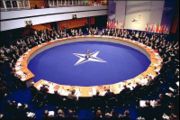 The independence of the Turkic states of the Soviet Union, with whom Turkey shares a common cultural and linguistic heritage, allowed Turkey to extend its economic and political relations deep into Central Asia. The most salient of these relations saw the completion of a multi billion dollar oil and gas pipeline from Baku in Azerbaijan to the port of Ceyhan in Turkey. The Baku-Tbilisi-Ceyhan pipeline, as it is called, has formed part of Turkey's foreign policy strategy to become an energy conduit to the West. However, Turkey's border with Armenia, a state in the Caucaus, remains closed following its occupation of Azeri territory during the Nagorno-Karabakh War. Relations with Armenia have been further strained by the controversy surrounding the forced deportations and related deaths of hundrends of thousands of Armenians in the last days of the Ottoman Empire, recognised by a number of countries and historians as the Armenian Genocide. Turkey rejects the term genocide, arguing instead that the deaths were a result of disease, famine and inter-ethnic strife.
The independence of the Turkic states of the Soviet Union, with whom Turkey shares a common cultural and linguistic heritage, allowed Turkey to extend its economic and political relations deep into Central Asia. The most salient of these relations saw the completion of a multi billion dollar oil and gas pipeline from Baku in Azerbaijan to the port of Ceyhan in Turkey. The Baku-Tbilisi-Ceyhan pipeline, as it is called, has formed part of Turkey's foreign policy strategy to become an energy conduit to the West. However, Turkey's border with Armenia, a state in the Caucaus, remains closed following its occupation of Azeri territory during the Nagorno-Karabakh War. Relations with Armenia have been further strained by the controversy surrounding the forced deportations and related deaths of hundrends of thousands of Armenians in the last days of the Ottoman Empire, recognised by a number of countries and historians as the Armenian Genocide. Turkey rejects the term genocide, arguing instead that the deaths were a result of disease, famine and inter-ethnic strife.
Administrative divisions
Bosphorus Bridge in Istanbul, connecting Europe (left) and Asia (right)Main articles: Regions of Turkey, Provinces of Turkey, Districts of Turkey, and List of cities in Turkey The capital city of Turkey is Ankara. The territory of Turkey is subdivided into 81 provinces for administrative purposes. The provinces are organized into 7 regions for census purposes; however, they do not represent an administrative structure. Each province is divided into districts, for a total of 923 districts.

Provinces usually bear the same name as their provincial capitals, also called the central district; exceptions to this are the provinces of Hatay (capital: Antakya), Kocaeli (capital: İzmit) and Sakarya (capital: Adapazarı). Provinces with the largest populations are İstanbul (+12 million), Ankara (+4.4 million), İzmir (+3.7 million), Bursa (+2.4 million), Adana (+2.0 million) and Konya (+1.9 million).
The biggest city and the pre-Republican capital İstanbul is the financial, economic and cultural heart of the country. Other important cities include İzmir, Bursa, Adana, Trabzon, Malatya, Gaziantep, Erzurum, Kayseri, Kocaeli, Konya, Mersin, Eskişehir, Diyarbakır, Antalya and Samsun. An estimated 70.5% of Turkey's population live in urban centers. In all, 18 cities have populations that exceed 1 million inhabitants, and 21 cities have populations between 1 million and 500,000 inhabitants. Only two cities have populations less than 100,000.
Major cities:
İstanbul - 12,573,836 Ankara - 4,466,756 İzmir - 3,739,353 Bursa - 2,439,876 Adana - 2,006,650 Konya - 1,959,082 Antalya - 1,789,295 Mersin - 1,595,938 Gaziantep - 1,560,023 Şanlıurfa - 1,523,099 Diyarbakır - 1,460,714 Kocaeli - 1,437,926 Hatay - 1,386,224 Manisa - 1,319,920 Samsun - 1,228,959
Geography and climate
Ölüdeniz near Fethiye in the Turkish RivieraTurkey is a transcontinental Eurasian country. Asian Turkey (made up largely of Anatolia), which includes 97% of the country, is separated from European Turkey by the Bosporus, the Sea of Marmara, and the Dardanelles (which together form a water link between the Black Sea and the Mediterranean). European Turkey (eastern Thrace or Rumelia in the Balkan peninsula) includes 3% of the country. The territory of Turkey is more than 1,600 kilometres (1,000 mi) long and 800 km (500 mi) wide, with a roughly rectangular shape. Turkey's area, inclusive of lakes, occupies 783,562 square kilometres (300,948 sq mi), of which 755,688 square kilometres (291,773 sq mi) are in Southwest Asia and 23,764 square kilometres (9,174 sq mi) in Europe. Turkey's area makes it the world's 37th-largest country, and is about the size of Metropolitan France and the United Kingdom combined. Turkey is encircled by seas on three sides: the Aegean Sea to the west, the Black Sea to the north and the Mediterranean Sea to the south. Turkey also contains the Sea of Marmara in the northwest.
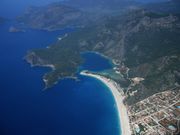 The European section of Turkey, in the northwest, is Eastern Thrace, and forms the borders of Turkey with Greece and Bulgaria. The Asian part of the country, Anatolia (also called Asia Minor), consists of a high central plateau with narrow coastal plains, between the Köroğlu and East-Black Sea mountain range to the north and the Taurus Mountains to the south. Eastern Turkey has a more mountainous landscape, and is home to the sources of rivers such as the Euphrates, Tigris and Aras, and contains Lake Van and Mount Ararat, Turkey's highest point at 5,165 metres (16,946 ft).
The European section of Turkey, in the northwest, is Eastern Thrace, and forms the borders of Turkey with Greece and Bulgaria. The Asian part of the country, Anatolia (also called Asia Minor), consists of a high central plateau with narrow coastal plains, between the Köroğlu and East-Black Sea mountain range to the north and the Taurus Mountains to the south. Eastern Turkey has a more mountainous landscape, and is home to the sources of rivers such as the Euphrates, Tigris and Aras, and contains Lake Van and Mount Ararat, Turkey's highest point at 5,165 metres (16,946 ft).
Turkey is geographically divided into seven regions: Marmara, Aegean, Black Sea, Central Anatolia, Eastern Anatolia, Southeastern Anatolia and the Mediterranean. The uneven north Anatolian terrain running along the Black Sea resembles a long, narrow belt. This region comprises approximately one-sixth of Turkey's total land area. As a general trend, the inland Anatolian plateau becomes increasingly rugged as it progresses eastward.
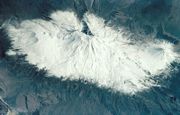 Mt. Ararat is the highest peak in Turkey at 5,165 m (16,946 ft)Turkey's varied landscapes are the product of complex earth movements that have shaped the region over thousands of years and still manifest themselves in fairly frequent earthquakes and occasional volcanic eruptions. The Bosporus and the Dardanelles owe their existence to the fault lines running through Turkey that led to the creation of the Black Sea. There is an earthquake fault line across the north of the country from west to east, which caused a major earthquake in 1999.
Mt. Ararat is the highest peak in Turkey at 5,165 m (16,946 ft)Turkey's varied landscapes are the product of complex earth movements that have shaped the region over thousands of years and still manifest themselves in fairly frequent earthquakes and occasional volcanic eruptions. The Bosporus and the Dardanelles owe their existence to the fault lines running through Turkey that led to the creation of the Black Sea. There is an earthquake fault line across the north of the country from west to east, which caused a major earthquake in 1999.
The coastal areas of Turkey bordering the Mediterranean Sea have a temperate Mediterranean climate, with hot, dry summers and mild, wet and cold winters. Conditions can be much harsher in the more arid interior. Mountains close to the coast prevent Mediterranean influences from extending inland, giving the central Anatolian plateau of the interior of Turkey a continental climate with sharply contrasting seasons. Winters on the plateau are especially severe. Temperatures of −30 °C to −40 °C (−22 °F to -40 °F) can occur in the mountainous areas in the east, and snow may lie on the ground 120 days of the year. In the west, winter temperatures average below 1 °C (34 °F). Summers are hot and dry, with temperatures generally above 30 °C (86 °F) in the day. Annual precipitation averages about 400 millimetres (15 in), with actual amounts determined by elevation. The driest regions are the Konya plain and the Malatya plain, where annual rainfall frequently is less than 300 millimetres (12 in). May is generally the wettest month, whereas July and August are the most dry.
Demographics
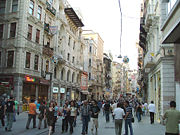 İstiklal Avenue in Istanbul's cosmopolitan Beyoğlu districtAs of 2007, the population of Turkey stood at 70.5 million with a growth rate of 1.04 % per annum.
İstiklal Avenue in Istanbul's cosmopolitan Beyoğlu districtAs of 2007, the population of Turkey stood at 70.5 million with a growth rate of 1.04 % per annum.
The average population density (the number of persons per square kilometer) is 92 in Turkey; this changes between 11 and 2,420 in the country's provinces.
Istanbul Province has the highest population density with 2,420 persons per square kilometer. The proportion of the population living in cities is 70.5 %.
Half of Turkey's population is below the age of 28.3. Persons within the 15-64 age group, i.e. the working ages, constitute 66.5 % of the total population.
The 0-14 age group corresponds to 26.4 % of Turkey's population; while senior citizens with 65 years of age or older correspond to 7.1 % of the total population. According to statistics released by the government in 2005, life expectancy stands at 68.9 years for men and 73.8 years for women, with an overall average of 71.3 years for the populace as a whole.
Education is compulsory and free from ages 6 to 15. The literacy rate is 95.3% for men and 79.6% for women, with an overall average of 87.4%. This low figure is mainly due to prevailing feudal attitudes against women in the Arab- and Kurdish-inhabited southeastern provinces of the country.
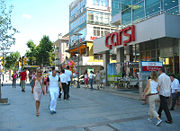 Article 66 of the Turkish Constitution defines a "Turk" as anyone who is "bound to the Turkish state through the bond of citizenship"; therefore, the legal use of the term "Turkish" as a citizen of Turkey is different from the ethnic definition. The majority of the Turkish population are of Turkish ethnicity.
Article 66 of the Turkish Constitution defines a "Turk" as anyone who is "bound to the Turkish state through the bond of citizenship"; therefore, the legal use of the term "Turkish" as a citizen of Turkey is different from the ethnic definition. The majority of the Turkish population are of Turkish ethnicity.
Other major ethnic groups include the Kurds, Circassians, Zazas, Roma, Arabs and the three officially-recognized minorities (per the Treaty of Lausanne) of Greeks, Armenians and Jews. The largest non-Turkic ethnicity is the Kurds, a distinct ethnic group traditionally concentrated in the southeast of the country. Minorities other than the three official ones do not have any special group privileges, and while the term "minority" itself remains a sensitive issue in Turkey, it is to be noted that the degree of assimilation within various ethnic groups outside the recognized minorities is high, with the following generations adding to the melting pot of the Turkish main body. Within that main body, certain distinctions based on diverse Turkic origins could be made as well. Reliable data on the exact ethnic repartition of the population is not available, as the Turkish census figures do not include ethnic or racial figures.
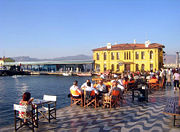 Due to a demand for an increased labor force in post-World War II Europe, many Turkish citizens emigrated to Western Europe (particularly West Germany), contributing to the creation of a significant diaspora. Recently, Turkey has also become a destination for numerous immigrants, especially since the fall of the Berlin Wall and the consequent increase of freedom of movement in the region. These immigrants generally migrate from the former Soviet Bloc countries, as well as neighboring Muslim states, either to settle and work in Turkey or to continue their journey towards the European Union.
Due to a demand for an increased labor force in post-World War II Europe, many Turkish citizens emigrated to Western Europe (particularly West Germany), contributing to the creation of a significant diaspora. Recently, Turkey has also become a destination for numerous immigrants, especially since the fall of the Berlin Wall and the consequent increase of freedom of movement in the region. These immigrants generally migrate from the former Soviet Bloc countries, as well as neighboring Muslim states, either to settle and work in Turkey or to continue their journey towards the European Union.
Cafés at the port of İzmirTurkish is the sole official language throughout Turkey. Reliable figures for the linguistic repartition of the populace are not available for reasons similar to those cited above. The public broadcaster TRT broadcasts programs in local languages and dialects of Arabic, Bosnian, Zazaish, Circassian and Kurdish a few hours a week.
Nominally, 99% of the Turkish population is Muslim of whom over 75% belong to the Sunni branch of Islam. A sizeable minority, about over 20% of the Muslim population, is affiliated with the Shi'a Alevi sect, which is also sometimes considered Yazdani. According to a Eurobarometer poll in 2005, 95% of Turkish citizens responded that "they believe there is a God". The mainstream Hanafite school of Sunni Islam is largely organized by the state, through the Diyanet İşleri Başkanlığı (Religious Affairs Directorate), which controls all mosques and Muslim clerics. The remainder of the population belongs to other faiths, particularly Christian denominations (Greek Orthodox, Armenian Apostolic, Syriac Orthodox), Judaism, and Yezidism.
There is a strong tradition of secularism in Turkey. Even though the state has no official religion nor promotes any, it actively monitors the area between the religions. The constitution recognizes freedom of religion for individuals, whereas religious communities are placed under the protection of the state; but the constitution explicitly states that they cannot become involved in the political process (by forming a religious party, for instance) or establish faith-based schools. No party can claim that it represents a form of religious belief; nevertheless, religious sensibilities are generally represented through conservative parties. Turkey prohibits by law the wearing of religious headcover and theo-political symbolic garments for both genders in government buildings, schools, and universities; the law was upheld by the Grand Chamber of the European Court of Human Rights as "legitimate" in Leyla Şahin v. Turkey on November 10, 2005.
Culture
Sufi whirling dervishesTurkey has a very diverse culture that is a blend of various elements of the Oğuz Turkic and Anatolian, Ottoman (which was itself a continuation of both Greco-Roman and Islamic cultures), and Western culture and traditions which started with the Westernization of the Ottoman Empire and continues today. This mix is a result of the encounter of Turks and their culture with those of the peoples who were in their path during their migration from Central Asia to the West. As Turkey successfully transformed from the religion-based former Ottoman Empire into a modern nation-state with a very strong separation of state and religion, an increase in the methods of artistic expression followed. During the first years of the republic, the government invested a large amount of resources into fine arts, such as museums, theatres, and architecture. Because of different historical factors playing an important role in defining the modern Turkish identity, Turkish culture is a product of efforts to be "modern" and Western, combined with the necessity felt to maintain traditional religious and historical values.
Orhan Pamuk, winner of the 2006 Nobel Prize in LiteratureTurkish music and literature form great examples of such a mix of cultural influences. Many schools of music are popular throughout Turkey, from "arabesque" to hip-hop genres, as a result of the interaction between the Ottoman Empire and the Islamic world along with Europe, and thus contributing to a blend of Central Asian Turkic, Islamic and European traditions in modern-day Turkish music. Turkish literature was heavily influenced by Persian and Arabic literature during most of the Ottoman era, though towards the end of the Ottoman Empire the effect of both Turkish folk and Western literary traditions became increasingly felt. The mix of cultural influences is dramatized, for example, in the form of the "new symbols [of] the clash and interlacing of cultures" enacted in the work of Orhan Pamuk, winner of the 2006 Nobel Prize in Literature.
Dolmabahçe Palace, IstanbulArchitectural elements found in Turkey are also testaments to the unique mix of traditions that have influenced the region over the centuries. In addition to the traditional Byzantine elements present in numerous parts of Turkey, many artifacts of the later Ottoman architecture, with its exquisite blend of local and Islamic traditions, are to be found throughout the country, as well as in many former territories of the Ottoman Empire. Since the 18th century, Turkish architecture has been increasingly influenced by Western styles, and this can be particularly seen in Istanbul where buildings like the Blue Mosque and the Dolmabahçe Palace are juxtaposed next to numerous modern skyscrapers, all of them representing different traditions.
The most popular sport in Turkey is football. Turkey's top teams include Galatasaray, Fenerbahçe and Beşiktaş. In 2000, Galatasaray cemented its role as a major European club by winning the UEFA Cup and UEFA Super Cup. Two years later the Turkish national team finished third in the 2002 World Cup Finals in Japan and South Korea. Other mainstream sports such as basketball, volleyball and motorsports (following the inclusion of Istanbul Park on the Formula 1 racing calendar) have also become popular recently. The men's national basketball team finished second in Eurobasket 2001 while Efes Pilsen S.K. won the Korac Cup in 1996, finished second in the European Cup of 1993, and made it to the Final Four of Euroleague and Suproleague in 2000 and 2001. Women's volleyball teams such as Eczacıbaşı and Vakıfbank Güneş Sigorta have been the most successful by far in any team sport, winning numerous European championship titles and medals. Surfing, snowboarding, skateboarding, paragliding and other extreme sports are becoming more popular every year. The traditional Turkish national sport has been the Yağlı güreş (Oiled Wrestling) since Ottoman times. International wrestling styles governed by FILA such as Freestyle wrestling and Greco-Roman wrestling are also popular, with many European, World and Olympic championship titles won by Turkish wrestlers both individually and as a national team. Another major sport in which the Turks have been internationally successful is weightlifting; as Turkish weightlifters, both male and female, have broken numerous world records and won several European, World and Olympic championship titles. Naim Süleymanoğlu and Halil Mutlu have achieved legendary status as one of the few weightlifters to have won three gold medals in three Olympics.